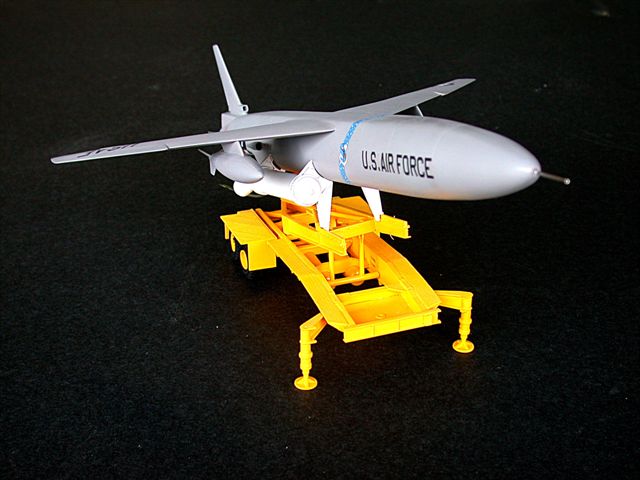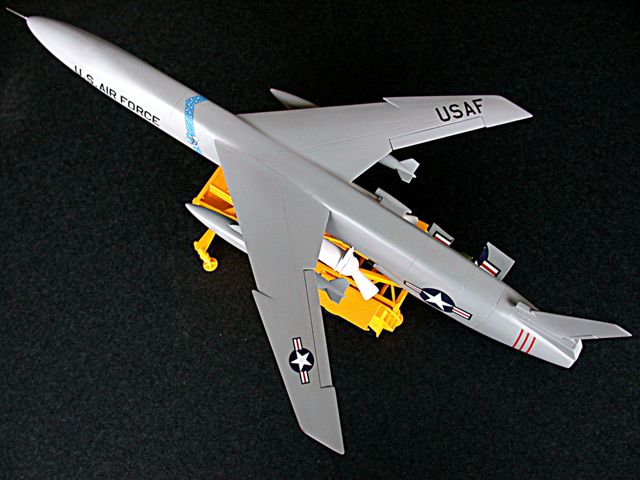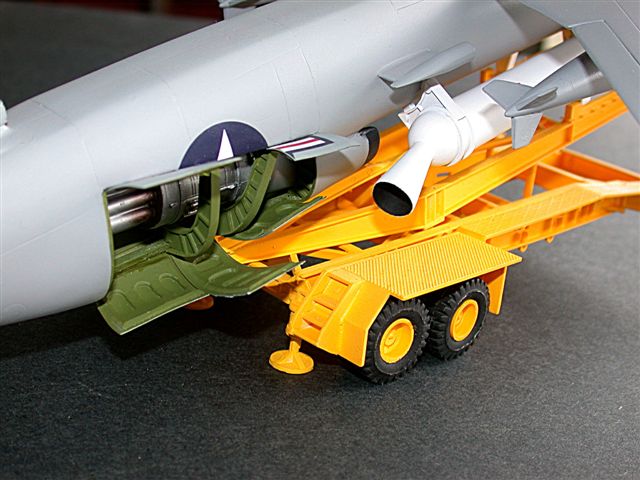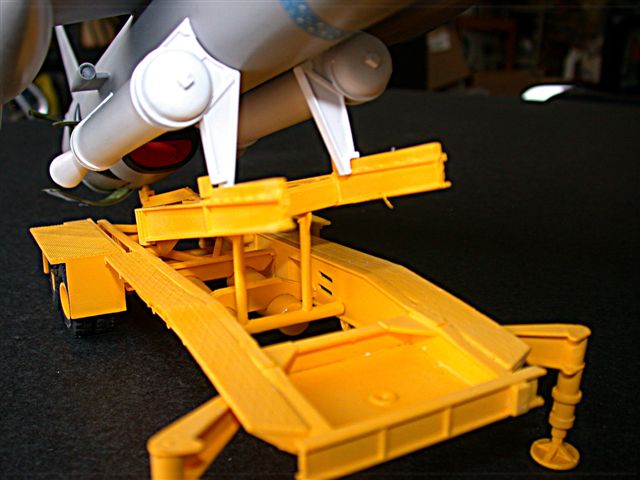Building the elderly Lindberg 1/48 kit
Snark Attack!
by
"Bondo" Phil Brandt
|

|
|
Northrop Snark |

Special
Hobby's 1/32 scale X-15A-2 is available online from
Squadron.com
Background
The Northrop “Snark” started life in the developmental tumult that raged in the post-WWII American aircraft industry. Responding to the 1945 USAAF requirements for a long range cruise missile, Northrop was awarded a contract to develop the subsonic “Snark” and the supersonic “Boojum.” Design and testing progressed on the initial Snark design, but due to government-reduced emphasis and two crashes, the first flight didn’t occur until 1951.
Because the Air Force kept significantly changing its load, speed and range requirements, the Snark was significantly re-designed, eventually designated under the new USAF missile naming system as the SM-62.
In 1953 President Eisenhower stepped up strategic missile development to the highest national priority, and testing got serious. The Snark went head-to-head with the North American X-10 Navajo cruise missile, and both companies used the Cape Canaveral test site.

What was to become a ten-year gestation for the Snark had more than its share of inflight failures, so many in fact that competing North American engineers used to refer to the waters off Cape Canaveral as “Snark-infested.”
The Snark’s guidance system performance was especially egregious over the five thousand mile planned range. The original combination of inertial/star tracking was hoped tp produce CEPs in the 2 nm range, but more often produced CEPs of 20 nm, not acceptable even with the blockbuster thermonuclear warheads then in production! Continued test results were so disappointing that in 1957 even the SAC commander, General Power, felt that the program should be cancelled; he was overridden at Air Force level.
In 1959 the Snark was finally deployed operationally as part of the first strategic missile wing ever formed in the Air Force, the 702nd at Presque Isle AFB, Maine. The first Snark went on alert in March 1960, to be soon joined by three others, and by February 1961 the missile wing was at long last designated “operationally ready.” Just one month later President Kennedy declared the program to be “...obsolete and of marginal military value.” The Snarks immediately stood down and by June of that year were gone forever.
The Kit
This is the ancient Lindberg, all right! Red plastic, boiler-sized rivets and raised panelling everywhere. Plus the same handy jet engine that accompanied so many of the firm’s releases of the 50s and 60s. But, when all’s said and done, dimensions seem close enough for government work, and there’s the neat launching trailer and mini-CAT towing vehicle that are part of the kit.
All surfaces were wet sanded to be totally free of raised detail and then the panels and lines were rescribed. Because there’s little complexity, such as a cockpit, to catch the eye, I chose to create an open engine compartment. The J48 engine from the Academy F-86 was used because I was unable to find a 1/48 J57, By the time the interior structure was scratchbuilt, it was reasoned that not enough engine would actually be showing anyhow. Engine compartment panels were also scratchbuilt.
Because Lindberg never offered any intake trunking, I chose to do the ol’ FOD cover trick. The exhaust tunnel was created from ½" plastic tube.
The launch trailer was built OOB. I eventually finally elected not to configure the scene with the tow-tractor and front wheel dolly attached to the launcher because the launch sites at Presque Isle were much more permanent.
Painting
As HyperScale brethren may already know, we at Bondo Industries usually favor definitive operational colors, as opposed to garish (in this case, especially) test markings as Lindberg provided in the kit. The Snark at the USAF Museum is done in gray, and your correspondent prefers the subdued gray against the stark chrome yellow trailer.

The trailer launcher was first sprayed out of the can with Tamiya white lacquer primer, and then received multiple coats of Tamiya chrome yellow lacquer, again from the spraycan. The missile proper was done in Tamiya gray lacquer primer, again een ze spraycan. The solid rocket boosters are in Tamiya white lacquer primer. The engine compartment is Testors acrylic interior green, and the engine, as always, is in Alclad II.
As these were SAC’s brand new, just-deployed missiles, no attempt was made to weather the assemblies; there’s no way they’d have been allowed to get dirty!
Decals
The operational bird has few decals, as opposed to the nightmare that would’ve been visited trying to do all those white test markings over a red base!

I used the SAC star-studded ribbon from an old Hasegawa B-47 sheet; the 1/72 scale ribbon seems to work fine on a 1/48 airframe. National insignia and stripes are from Aeromaster.
The extremely short operational career of the Snark should not be summarily dismissed, because its ten-year development in so many areas paved the way for SAC’s successful strategic missiles of the following twenty years.
Model, Images and
Text Copyright © 2008 by "Bondo" Phil Brandt
Page Created 13 May, 2008
Last Updated 13 May, 2008
Back to HyperScale
Main Page
|
Home
| What's New |
Features |
Gallery |
Reviews |
Reference |
Forum |
Search